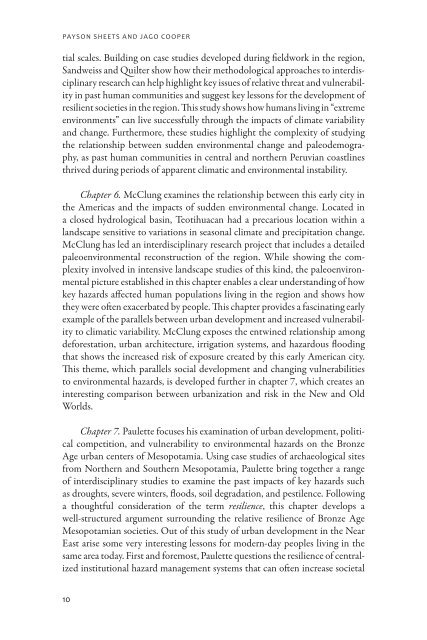free download - University Press of Colorado
free download - University Press of Colorado
free download - University Press of Colorado
Create successful ePaper yourself
Turn your PDF publications into a flip-book with our unique Google optimized e-Paper software.
Payson Sheets and Jago Cooper<br />
tial scales. Building on case studies developed during fieldwork in the region,<br />
Sandweiss and Quilter show how their methodological approaches to interdisciplinary<br />
research can help highlight key issues <strong>of</strong> relative threat and vulnerability<br />
in past human communities and suggest key lessons for the development <strong>of</strong><br />
resilient societies in the region. This study shows how humans living in “extreme<br />
environments” can live successfully through the impacts <strong>of</strong> climate variability<br />
and change. Furthermore, these studies highlight the complexity <strong>of</strong> studying<br />
the relationship between sudden environmental change and paleodemography,<br />
as past human communities in central and northern Peruvian coastlines<br />
thrived during periods <strong>of</strong> apparent climatic and environmental instability.<br />
Chapter 6. McClung examines the relationship between this early city in<br />
the Americas and the impacts <strong>of</strong> sudden environmental change. Located in<br />
a closed hydrological basin, Teotihuacan had a precarious location within a<br />
landscape sensitive to variations in seasonal climate and precipitation change.<br />
McClung has led an interdisciplinary research project that includes a detailed<br />
paleoenvironmental reconstruction <strong>of</strong> the region. While showing the complexity<br />
involved in intensive landscape studies <strong>of</strong> this kind, the paleoenvironmental<br />
picture established in this chapter enables a clear understanding <strong>of</strong> how<br />
key hazards affected human populations living in the region and shows how<br />
they were <strong>of</strong>ten exacerbated by people. This chapter provides a fascinating early<br />
example <strong>of</strong> the parallels between urban development and increased vulnerability<br />
to climatic variability. McClung exposes the entwined relationship among<br />
deforestation, urban architecture, irrigation systems, and hazardous flooding<br />
that shows the increased risk <strong>of</strong> exposure created by this early American city.<br />
This theme, which parallels social development and changing vulnerabilities<br />
to environmental hazards, is developed further in chapter 7, which creates an<br />
interesting comparison between urbanization and risk in the New and Old<br />
Worlds.<br />
Chapter 7. Paulette focuses his examination <strong>of</strong> urban development, political<br />
competition, and vulnerability to environmental hazards on the Bronze<br />
Age urban centers <strong>of</strong> Mesopotamia. Using case studies <strong>of</strong> archaeological sites<br />
from Northern and Southern Mesopotamia, Paulette bring together a range<br />
<strong>of</strong> interdisciplinary studies to examine the past impacts <strong>of</strong> key hazards such<br />
as droughts, severe winters, floods, soil degradation, and pestilence. Following<br />
a thoughtful consideration <strong>of</strong> the term resilience, this chapter develops a<br />
well-structured argument surrounding the relative resilience <strong>of</strong> Bronze Age<br />
Mesopotamian societies. Out <strong>of</strong> this study <strong>of</strong> urban development in the Near<br />
East arise some very interesting lessons for modern-day peoples living in the<br />
same area today. First and foremost, Paulette questions the resilience <strong>of</strong> centralized<br />
institutional hazard management systems that can <strong>of</strong>ten increase societal<br />
10





